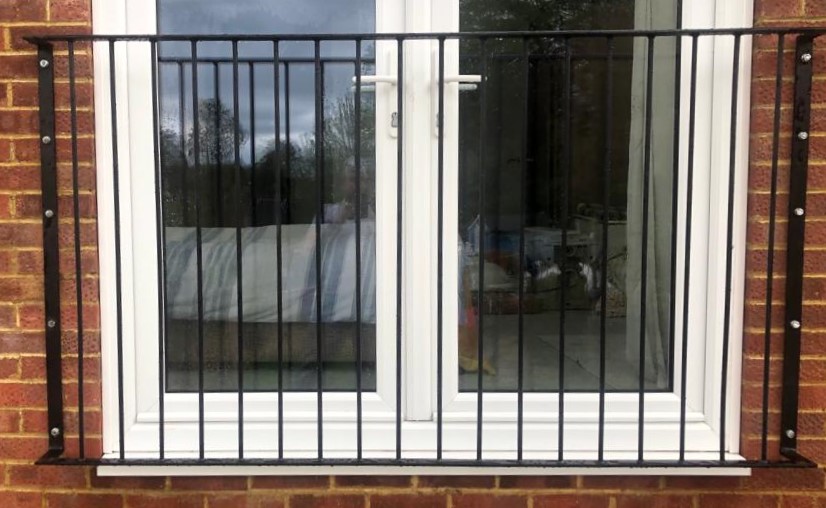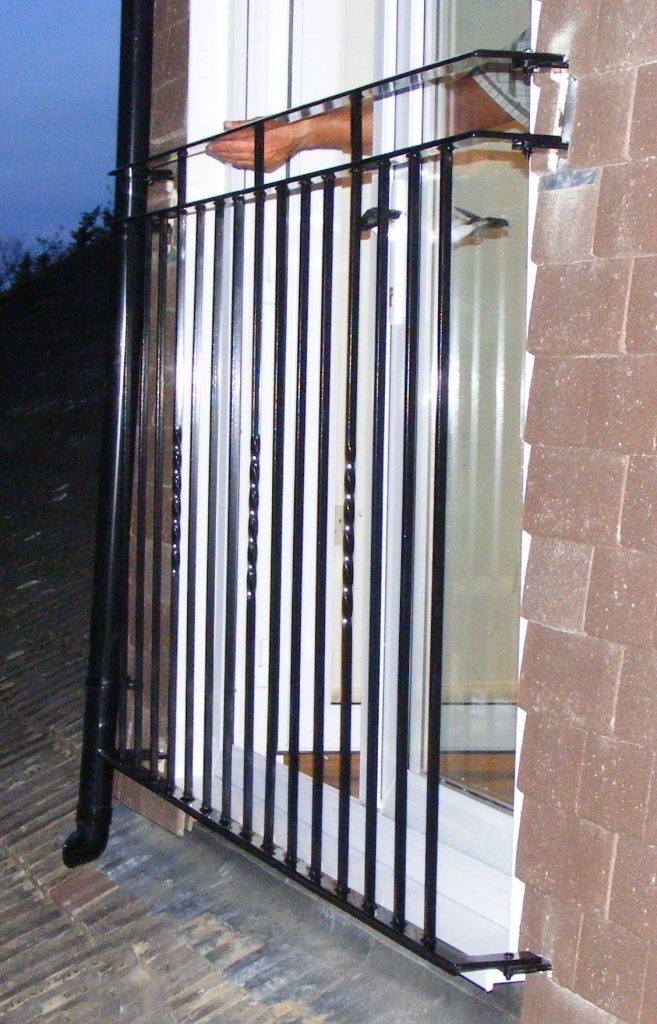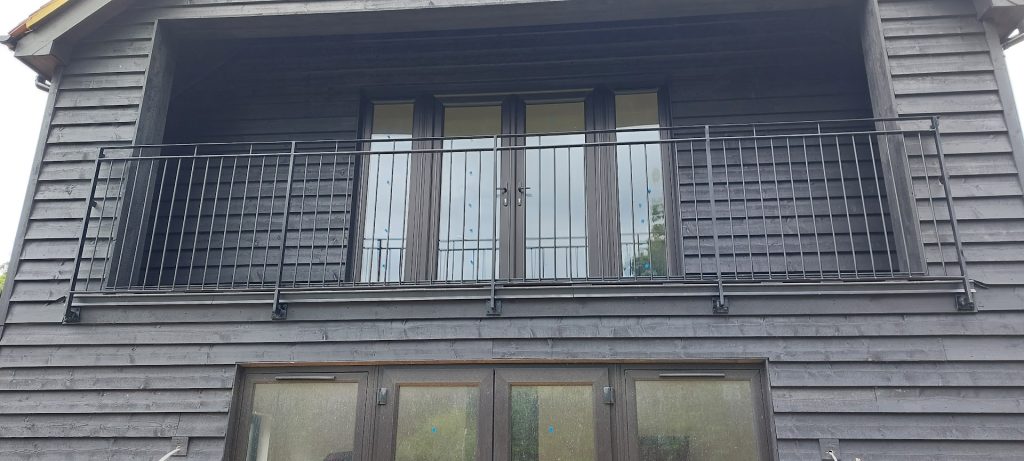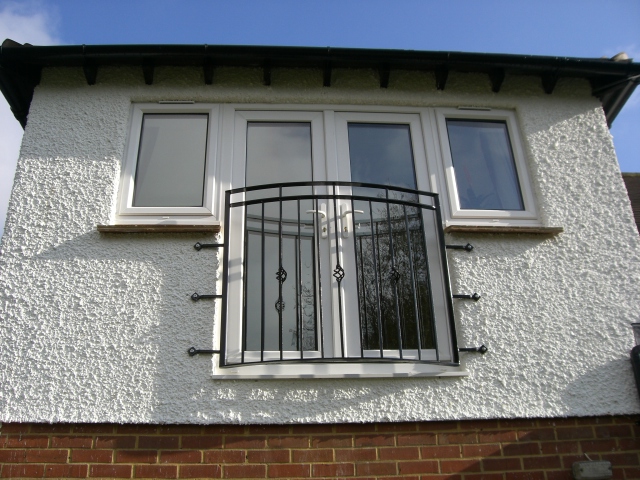Metal Juliet balcony railings, Made to measure. from brick fixing to tile hung, building regulation compliant. Building regulations UK, require that the juliette balcony railing is 1100mm high from floor level and that a sphere of 100mm cannot pass through any gap. This applies for all types of Juliet balcony railings.

All our metal juliet balcony railing designs avoid using single point fixings, that is one fixing in each corner. These use a bar that runs from top to bottom of the juliet balcony railing spreading the load more evenly, providing a much safer fixing.
A metal Juliet balcony railing or balconette spans a set of inward opening doors (french doors) above the ground floor. This stops you falling out, because of this fixing is ultimately important. If you fix to a brick built house, then your juliet balcony railing requirement is at least 300mm wider than the door frame. As your juliet balcony railing fixing points will be 150mm away from the edge of the Bricks each side. This allows good solid fixing without risk of cracking the bricks, resulting in an unsafe fixing.
Our metal Juliet Balcony railings protrude by 80mm (3 inches). This allows the balconette clearance of the door handles and the door sill and are building regulation uk compliant.
If your door is 1200mm wide, you will need a balcony railing that is at least 1500mm, this ensures a solid fixing.
Tile hung Juliet balcony railings.
Tile hung metal Juliette balconies, require different method of fixing because you can not just bolt through the tiles. Because they would simply crack under compression of fixing, resulting in an unsafe fixing.
When doors are fitted a structural timber will have been used. So if the house is timber frame and tile hung, this will have been put in place to fix the doors. This usually means the balcony needs to be about 100mm larger than the door size. Fixing a plate to the structural timbers with lugs that protrude beyond the tiles. When the tiles are rehung, this allows the metal Juliet balcony railing fixing to bolt to the lugs.
If the house is tile hung with block work construction. We employ the same method, except that a backing plate is supplied, so that the brackets are “clamped” to the wall. Steel brackets on the outside and a plate inside with the blocks sandwich in between. The 300mm larger rule would still apply for this method of fixing.

Here, the Juliet balcony railing bolted to the lug sticks out of the tiles. The tiles then neatly cut around the lug. Sealed making them water proof for a good strong fixing for the balcony.
Its often the case that brackets are made and fitted first,. The steel Juliet balcony made later, once the brackets are in place. This gives an exact size for the Juliette balcony. This is sometimes useful for the builders carrying out the work. The Juliet balcony then fitted at a much later stage, allowing access via the doors with out the Juliet balcony causing an obstruction..

Large Juliet balcony railings
A 6mtr steel Juliet balcony railing fixed to a new timber framed house in Copthorne. To much weight to just rely on just side fixings. The design had to support the weight from the bottom. Structural timber on the floor allowed “posts” incorporated into the design to help carry the weight of the balcony. A double top bar design helped increase strength and rigidity of the Juliet balcony..

Low side windows.

This steel Juliet balcony railing in Redhill, Surrey. Design to get around low side windows. A normal Juliet balcony would need to span past the windows, this would have stopped the windows opening. The oversize balcony would cost more than needed, because of the size required to span the windows.
The juliet balcony made to a tight fit to the door gap, then fixing lugs extended out to ensure there a good solid fixing. 150mm each side wider than the doors.
Black, a common colour but with Anthracite doors now being popular. Anthracite coloured Juliette balconies are now quite common place.
Building regulations usually apply to a Juliet balcony railing. So 1100mm high and no gap larger than 100mm.
Juliet Balcony railing fixing
I really cannot stress how important it is to make sure you balcony has a good solid fixing. Its main purpose is to stop anyone falling out of the french doors.. As such there are rules and regulations for this. in short it needs to be able to withstand a force of 74kg force per square mtr. So a 1500mm wide x 1100mm tall balcony needs to withstand over 120kg of force. Any well made steel juliet balcony is going to exceed those rules by a large factor. But its not just the balcony that is important its the fixing of the balcony. Steel is very predictable, depending on the type it has a shearing force of around 300N per mm2 (30kg).
Bricks on the other hand are far less predictable. If a wall fixing fails, its going to be a very rare occurrence that the fixing broke. It is far more likely that the brick cracked when the fixing was drilled or applied, or that it was just a soft brick not capable of holding the fixing in place with the force being applied to it. I really can not remember the number of times I have fitted a railing to a wall, and just given it one last tighten to make sure its in place, for it to tear out of the wall.. It must number in the hundreds.
method of fixing to avoid
For that reason alone i would never design a balcony with single point fixings, that is one fixing in each corner of the balcony. If one of those top fixing fail, the balcony comes away from the wall and is likely to come crashing to the floor with who ever is leaning against it. I also avoid cluster fixings, that is several fixings close to each other. best example of cluster fixing i can give is a plate in each corner with several fixings in the plate. If you crack the brick with one fixing that crack is likely to connect to the adjacent fixings. Again rendering an unsafe balcony fing likely to cause injury. Its cheaper to make a balcony with single point or cluster fixing, but in my personal opinion its unsafe.
What i use is a flat bar that connects the top and bottom of the balcony with a series of 5 holes specifically spaced for fixing. You may have noticed it on the photograph at the top of the page. My theory behind this is that each fixing goes into a different brick which is obviously a good thing. But should the top fixing fail in any way, the balcony is still firmly attached to the wall. Should the one below that also fail there is still more than enough strength to hold the balcony in position. but it should be noticeable that there is an issue with the fixings. And its time to seek the advice of a builder and get the fixings replaced.
I am not unique in the way i do my fixings for Juliet balconies, a good few other companies out there do it the same way, and i am guessing for the same reasons as me they feel its a safer and stronger method of fixings. Despite the fact it is a more expensive way to do it. its always got to be safety first and cost after. Never cost first and safety as an after thought.
I cannot advise what masonry fixings to use to fix a balcony to the wall i am not a builder. But a lot of the ones i do work for seem to use chemical resin as a prefered method of fixing. In short you drill a hole in the wall, insert the chemical resin, then place a piece of threaded rod in hole. wait for the resin to set. then bolt the balcony to the threaded rod that sticks out. Its a non expansionary fixing, so no chance of cracking the wall when tightening the fixings. Slower than something like rawl bolts because you have to allow time for the resin to set (temperature dependant about 30 mins) and more expensive.
Video of a corner being made
Video shows how we usually make up a corner joint on a metal juliet balcony railing. Because the balcony needs to protrude slightly from the wall, to ensure clearance from the door handles and window seal. It has a small return usually 80mm.
Its 8 x faster than real life. This. usually takes around 10 minutes to make up each corner to a good finish
Important advise for consideration.
If you have small children. It is unadvisable for a design that they can climb. That is anything they might get a foothold on and climb over.
This is often a missed piece of advice but, none the less important. A scrolled pattern may allow a small child to put there foot in the scrolls and use this to climb on.
For prices on Juliet balcony railings click on the button below